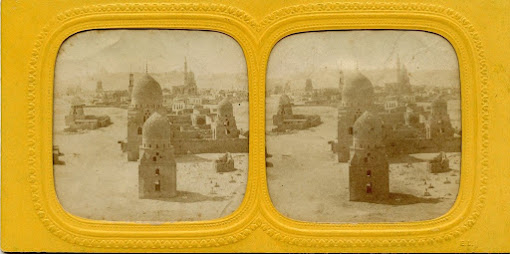The above is an 1870s view of the Sphinx and the great pyramid at Giza this is an early very rare French tissue card that has a second layer of tissue behind the tissue photograph which is colored in absurd pink and green so that when the light passes through these colors show through. As one can imagine these tissue windows are easily broken. Egypt is an uncommon subject of these tissue cards which often center around prominent rooms in European palaces and gardens.
Francis Frith was an early photographer photographing Egypt's and Nubia's monuments in the late 1850s. The above example shows the now lost temple of Gerf Hussein of which today the temple's inner sanctum lies at the bottom of Lake Nassar. Note the photographers signature in the bottom left corner.
Felix Bonfils was an early photographer of the middle east including Egypt and was the first photographer to market images of the middle east on a large scale certainly nothing like the companies that followed like Keystone or Underwood & Underwood. Here we have the temple of Dendur which today resides at 1000 5th Avenue New York in the Metropolitan Museum of Art. Felix Bonfils cards in good condition run from around $50-$100 and up each.
This card is a typical example of an Ingersoll card which was made on thinner cardboard in the early twentieth century 100 years later these cards have not curled the way most older stereo-views have. Ingersoll cards are in color but the same subjects also can be found in black and white. The reader would be advised to avoid buying Ingersoll, Keystone, and Underwood cards as singles as most are very common and are a better value buying in lots. Very similar cards were also distributed in cereal containers and are marked as such on the back.
As stereoscope cards go this is a visual time machine that takes the viewer back more than 100+ years to this museum display. Today the pharaoh's mummy is no longer presented in his original coffin but in a hermetically sealed glass case under a piece of fine linen as befits the great king's dignity, unfortunately, the king's arms are no longer exposed. This like many Keystone cards can also be found in sepia by Underwood. The era of the stereoscope was between ca.1858-1939 which is around 80 years so many cards including this one are very common even today a century later though some sellers will try to convince the buyer that they are rare they are not. King Seti's mummy should be listed as a must-have in any Egyptian collection and is easily found for sale on the internet.
To start your own collection buy a nice condition stereo-viewer with a few dozen cards this should cost about $100, make sure the sliding bar that holds the cards is present often they are sold missing this element be picky get a nice intact one they are common. Back in the heyday of stereo-views the machine was often given away for free.
Here we have a card by H. C. White whose production output began in 1899 and was almost as great as Keystone and Underwood though, the quality of White's stereo-views are of higher standards than its rivals.
Finally many cards are overpriced so shop around you never know when something hard to find like this card of Seti 1's mummy,( though it says it is the mummy of Ramses 2). Have fun!






